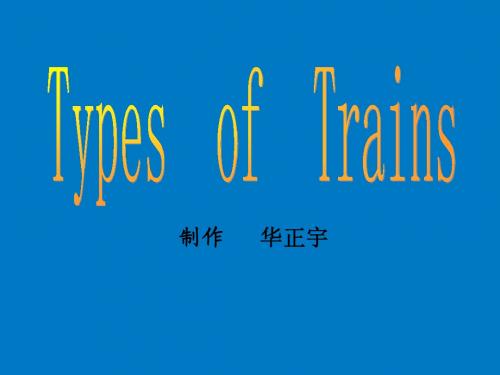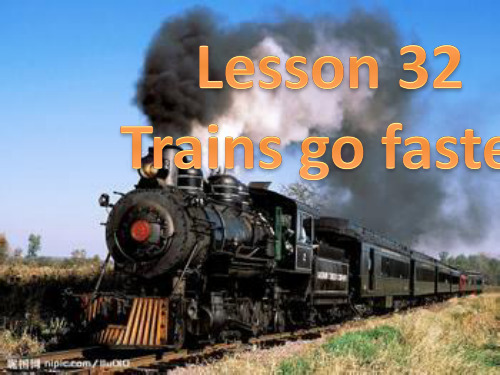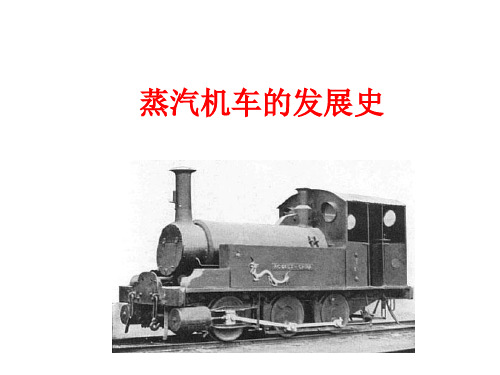早期蒸汽机车 Early Steam Trains
- 格式:ppt
- 大小:1.61 MB
- 文档页数:11

Unit 4TrainA train is a connected series of vehicles for rail transport that move along a track to transport cargo or passengers from one place to another. The track usually consists of two rails, but might also be a monorail or maglev guideway.Propulsion for the train is provided by a separate locomotive. Most modern trains are powered by diesel locomotives, although historically (from the early 19th century to the mid-20th century) the steam locomotive was the dominant form of locomotive power.There are various types of train designed for particular purposes. A train can consist of one or more locomotives and attached railroad cars.A passenger train may consist of one or several locomotives, and one or more coaches. Passenger trains travel between stations, at which passengers may board and disembark. In most cases, passenger trains operate on a fixed schedule and have superior track occupancy rights over freight trains.Oversight of a passenger train is the responsibility of the conductor. He or she is usually assisted by other crew members, such as service attendants or porters. During the heyday of North American passenger rail travel, long distance trains carried two conductors: the aforementioned train conductor, and a Pullman conductor, the latter being in charge of sleeping car personnel.Some passenger trains, both long distance and short distanced, may use bi-level (double-decker) cars to carry more passengers per train. Car design and the general safety of passenger trains have dramatically evolved over time, making travel by rail remarkably safe.Freight trains comprise wagons , though some parcel and mail trains are more like passenger trains. Much of the world's freight is transported by train, and in the United States the rail system is used more for transporting freight than passengers. Under the right circumstances, transporting freight by train is highly economic, and also more energy efficient than transporting freight byroad. Rail freight is most economic when freight is being carried in bulk and over long distances, but is less suited to short distances and small loads.译文列车列车是铁路运输中连接起来的一组车辆,它们在轨道上行驶,从一地向另一地运输旅客或货物。

介绍高铁英语作文模板英文回答:Introduction to High-Speed Rail。
High-speed rail (HSR) is a modern mode oftransportation that has revolutionized the way people travel. It is characterized by its high speed, efficiency, and comfort. HSR systems have been built in many countries around the world, including China, Japan, France, Germany, and Spain.History of HSR。
The history of HSR can be traced back to the early 19th century when steam locomotives were first used to pull passenger trains. In the 20th century, diesel and electric locomotives were developed, which allowed for faster speeds. However, it was not until the 1960s that the firstdedicated HSR line was built in Japan. This line, known asthe Shinkansen, was an instant success and paved the way for the development of HSR systems in other countries.How HSR Works。
HSR systems typically use dedicated tracks that are designed for high speeds. These tracks are often elevated or underground, which allows trains to avoid traffic and other obstacles. HSR trains are also equipped with special aerodynamic features that reduce drag and allow for faster speeds.Benefits of HSR。




货物运输英语作文英文回答:The Evolution of Freight Transportation.The transportation of goods has been a fundamental aspect of human society since the dawn of civilization. Over the centuries, the methods and technologies used to move freight have undergone significant evolution, driven by technological advancements, economic factors, and changing demographics.Early Methods.In ancient times, goods were primarily transported by human beings or animals, such as donkeys or camels, over land. As societies grew and trade expanded, these methods became increasingly inadequate. Ships, driven by wind or sail, emerged as a more efficient means of transporting goods across water bodies.The Rise of Railways.The invention of the steam engine in the 19th century ushered in a new era of freight transportation. Railways, powered by steam locomotives, provided a faster and more reliable way to move goods over long distances. They revolutionized the transportation industry, enabling the mass production and distribution of goods.The Advent of Trucks and Automobiles.The 20th century witnessed the emergence of trucks and automobiles as major modes of freight transportation. These vehicles offered greater flexibility and convenience, allowing goods to be delivered directly to businesses and consumers. Trucks became particularly important for short-haul and specialized deliveries.Air Freight.The advent of air freight in the mid-20th centuryfurther expanded the possibilities for freight transportation. Airplanes provided a faster and moreefficient way to move time-sensitive and high-value goods over long distances. Air freight became essential for international trade and the distribution of perishable products.Intermodal Transportation.In recent decades, intermodal transportation has emerged as a sustainable and efficient way of moving freight. This involves the seamless transfer of goods between different modes of transportation, such as ships, trains, trucks, and airplanes. Intermodal transportation reduces shipping costs and environmental impact.Current Trends and Future Prospects.Today, the freight transportation industry isundergoing rapid transformation. Technological advancements, such as automation and artificial intelligence, are revolutionizing the way goods are moved. Electric vehicles,powered by renewable energy, are becoming increasingly common. Data analytics and cloud computing are enablingreal-time tracking and optimization of freight shipments.Looking ahead, the future of freight transportation is expected to be marked by continued technological innovation, sustainability, and globalization. Autonomous vehicles and drones are likely to play a significant role in delivering goods efficiently and cost-effectively. Advanced infrastructure and intermodal transportation systems will facilitate seamless and efficient movement of freight.中文回答:货运运输的演变。
从火车到高铁的发展史的作文The history of the development from trains to high-speed rail is a fascinating journey that has revolutionized transportation in many countries. 火车发展到高铁的历史是一个令人着迷的旅程,它已经在许多国家彻底变革了交通运输。
The transition from traditional trains to high-speed rail has been a gradual process, marked by advancements in technology, infrastructure, and engineering. 从传统火车到高铁的过渡是一个渐进的过程,标志着技术、基础设施和工程的进步。
It has not only made travel faster and more efficient, but also transformed the way people commute and connect with one another. 它不仅使旅行变得更快更高效,还改变了人们的通勤方式以及彼此之间的联系方式。
The history of trains dates back to the early 19th century, when steam-powered locomotives were first introduced. 火车的历史可以追溯到19世纪初,当时首次引入了蒸汽动力机车。
These steam trains revolutionized transportation, making it easier for people to travel long distances in a relatively short amount of time. 这些蒸汽火车彻底改变了交通运输,使人们能够在相对较短的时间内轻松地旅行长距离。
五年级英语交通工具发展历程词汇单选题50题1.There was a man riding on a horse and carrying a letter. What was he riding?A.carB.bicycleC.horseD.plane答案:C。
选项A“car”是汽车;选项B“bicycle”是自行车;选项C“horse”是马;选项D“plane”是飞机。
题干中明确提到男人骑着马,所以正确答案是horse。
2.In ancient times, people used to travel long distances by carriage. What is a carriage?A.trainB.busC.carriageD.motorbike答案:C。
选项A“train”是火车;选项B“bus”是公共汽车;选项C“carriage”是马车;选项D“motorbike”是摩托车。
题干中提到古代人们用马车长途旅行,所以正确答案是carriage。
3.Ancient people sometimes went on a journey by boat. What kind of transportation is a boat?A.shipB.planeC.boatD.helicopter答案:C。
选项A“ship”是轮船;选项B“plane”是飞机;选项C“boat”是小船;选项D“helicopter”是直升机。
题干中说古代人有时乘船旅行,所以正确答案是boat。
4.In ancient battles, soldiers rode on chariots. What is a chariot?A.bicycleB.carC.chariotD.motorcycle答案:C。
选项A“bicycle”是自行车;选项B“car”是汽车;选项C“chariot”是战车;选项D“motorcycle”是摩托车。
火车发展作文英语模板英文回答:The evolution of the train has transformed the transportation industry and played a pivotal role in shaping modern civilization. From the humble beginnings of steam-powered locomotives to the high-speed bullet trains of today, the development of the train has been marked by continuous innovation and technological advancements.Steam Locomotives:The birth of the train can be traced back to the early 19th century when steam engines were harnessed to power locomotives. In 1804, Richard Trevithick introduced the first working steam locomotive, which could pull a load of 10 tons at a speed of around 5 miles per hour. This invention marked a major breakthrough in transportation technology and laid the foundation for the railway systems that would soon crisscross the globe.Diesel Locomotives:In the mid-20th century, diesel engines replaced steam engines as the primary power source for locomotives. Diesel locomotives offered several advantages over steam locomotives, including greater efficiency, lower operating costs, and reduced emissions. The widespread adoption of diesel locomotives helped to modernize railway systems and improve the overall performance of trains.Electric Locomotives:Electric locomotives, powered by electricity drawn from overhead wires or third rails, emerged as a more environmentally friendly and energy-efficient alternative to diesel locomotives. Electric locomotives areparticularly well-suited for urban areas and high-speed passenger rail lines. The development of electric locomotives has contributed significantly to reducing greenhouse gas emissions and improving air quality.High-Speed Rail:The quest for faster and more efficient train travel led to the development of high-speed rail systems. High-speed trains, such as the Japanese Shinkansen and the French TGV, operate at speeds of over 200 miles per hour, significantly reducing travel times and enhancing the convenience of long-distance rail travel.Magnetic Levitation Trains:Magnetic levitation (maglev) trains represent the cutting edge of train technology. Maglev trains levitate above the tracks using magnetic forces, eliminatingfriction and enabling speeds of up to 300 miles per hour. Maglev trains have the potential to revolutionize high-speed rail travel and offer a glimpse into the future of transportation.Impact of Trains on Society:The development of the train has had a profound impacton society. Trains have facilitated the transportation of goods and people over long distances, stimulating economic growth and fostering cultural exchange. Railways have played a crucial role in nation-building and urbanization, connecting cities and regions and promoting the development of new industries.Conclusion:The evolution of the train is a testament to human ingenuity and the relentless pursuit of progress in transportation. From humble beginnings to today's cutting-edge high-speed rail systems, trains have played a pivotal role in shaping our world. As technology continues to advance, the future of train travel holds the promise of even greater speed, efficiency, and environmental sustainability.中文回答:火车的演变。